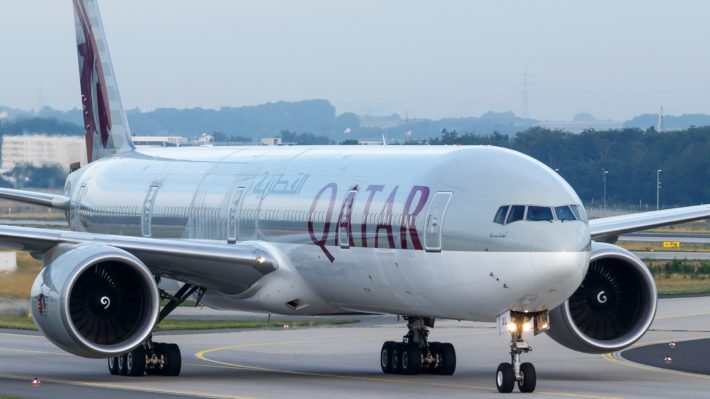The flight between Jacarepaguá Airport (RRJ) in Rio de Janeiro and Congonhas Airport (CGH) in São Paulo is among the most scenic I have ever taken in Brazil. Operated by Azul Conecta, this journey offers a stunning aerial view of the coastline of Rio de Janeiro and São Paulo.
Throughout the flight, numerous points of interest unfold below. It is truly breathtaking to see from above places that you may have only visited on the ground.
This route primarily serves corporate passengers traveling between São Paulo and Rio de Janeiro’s western zone. However, it is also a fantastic option for tourists, particularly those staying in Rio’s western neighborhoods: Barra da Tijuca, Recreio dos Bandeirantes, São Conrado, and Joá.
For travelers in these neighborhoods, getting to or from Santos Dumont (SDU) or Galeão (GIG) airports can take over an hour. In contrast, under normal traffic conditions, reaching Jacarepaguá Airport (RRJ) from Barra da Tijuca takes only about 20 minutes.
This article provides an in-depth look at what it’s like to fly between Rio de Janeiro and São Paulo with Azul Conecta. Check it out!
About Azul Conecta
Azul Conecta (ICAO: ACN) is a subsidiary of Azul Linhas Aéreas specializing in sub-regional flights. It originated from TwoFlex, a Jundiaí-based airline acquired by Azul in January 2020.
Since August 2020, the airline has operated under the Azul Conecta brand, acting as a feeder service for Azul’s larger network. Sub-regional aviation is characterized by flights on smaller aircraft, accommodating up to 19 passengers and connecting small and medium-sized cities to regional hubs or major metropolitan centers.
Currently, Azul Conecta operates 27 Cessna 208B Grand Caravan aircraft, including 24 passenger planes and 3 cargo planes (source: Panrotas – Jan/2023). The airline performs over 80 daily flights to 74 destinations.
One of its most notable routes is the Emotions Route (“Rota das Emoções”), connecting Fortaleza (CE) and São Luís (MA) via Jericoacoara (CE), Parnaíba (PI), and Barreirinhas (MA), offering breathtaking views of the Lençóis Maranhenses (flights to some of these destinations will unfortunately be suspended in March 2025).
Another standout route is the flight between Jacarepaguá and Congonhas, which, in my opinion, is even more spectacular.
Cessna Grand Caravan
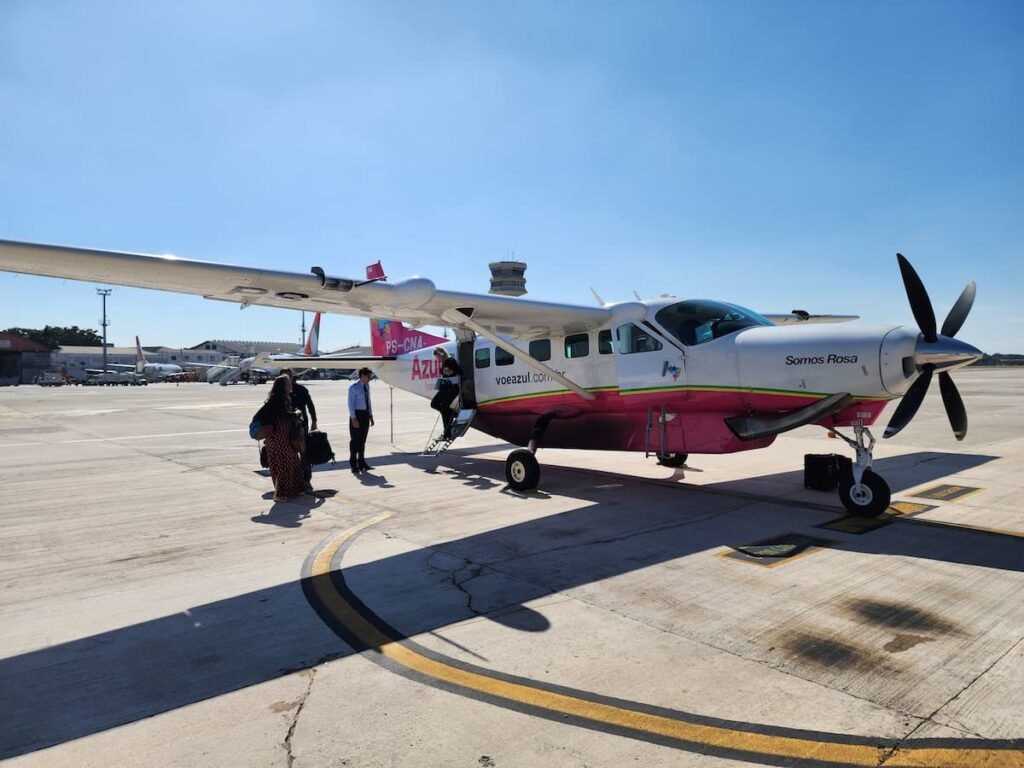
The Cessna Grand Caravan is a high-wing, single-engine turboprop aircraft manufactured by the Cessna Aircraft Company since 1982. Known for its versatility, reliability, and efficiency, it is a larger and more powerful version of the Cessna 208 Caravan.
The latest model, the Cessna Grand Caravan EX, is more fuel-efficient and quieter than its predecessors. The aircraft (Cessna Grand Caravan Ex-Pod) has a range of 912 nautical miles (1,689 km), allowing it to operate routes such as São Paulo to Cuiabá (1,689 km). Its maximum operating altitude is 25,000 feet (7,600 meters), and it cruises at 185 knots (343 km/h).
The aircraft seats nine passengers and two crew members, with a flexible cabin configuration. The seating arrangement consists of three rows of three seats, each featuring one single seat and one double seat.
In addition to Azul Conecta, several Brazilian companies operate the Cessna Grand Caravan: Abaeté Linhas Aéreas, ASTA Linhas Aéreas, Piquiatuba Táxi Aéreo, and Rima Taxi Aéreo. The Brazilian Air Force has 32 units of this aircraft.
In United States, several major airlines operate the Cessna Grand Caravan for regional and commuter flights. Surf Air is one of the largest operators of Caravans in the U.S., using them for scheduled commuter services. FedEx Express is the single largest operator, with a fleet of 239 Cessna 208 aircraft used for cargo operations. Other notable operators include: Southern Airways, Mokulele Airlines, Kenmore Air, Grand Canyon Scenic Airlines and Grant Aviation.
Unique Aspects of Azul Conecta Flights
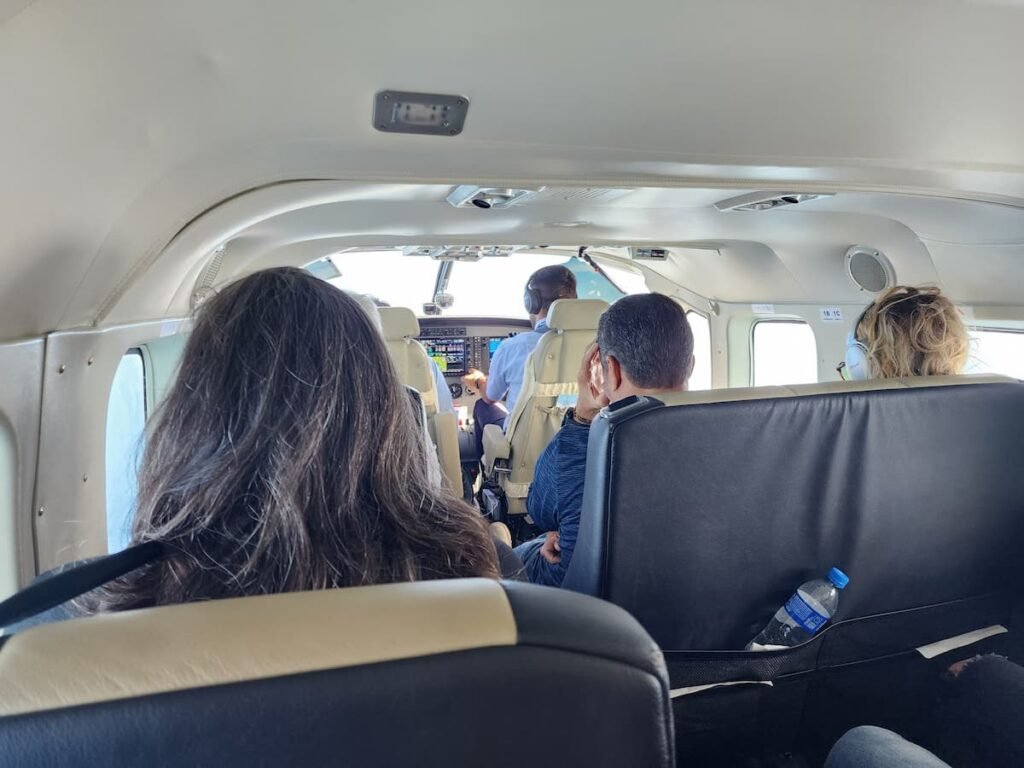
Azul Conecta flights differ from regular commercial flights in several ways, offering both advantages and drawbacks:
-
Smaller aircraft (up to nine passengers), providing a more intimate travel experience.
-
Lower flight altitude allows for a more detailed view of the landscape.
-
Larger windows compared to medium and large aircraft, enhancing sightseeing opportunities.
-
No onboard toilets, so passengers should use airport facilities before boarding.
-
No in-flight service, though Azul Conecta provides a self-serve cooler with unlimited snacks and drinks.
-
Online check-in is mandatory for departures from Jacarepaguá (RJ), as there is no check-in counter at this airport.
-
Higher risk of flight cancellations, as operations depend on favorable visual flight conditions.
Is it safe to travel with Azul Conecta?
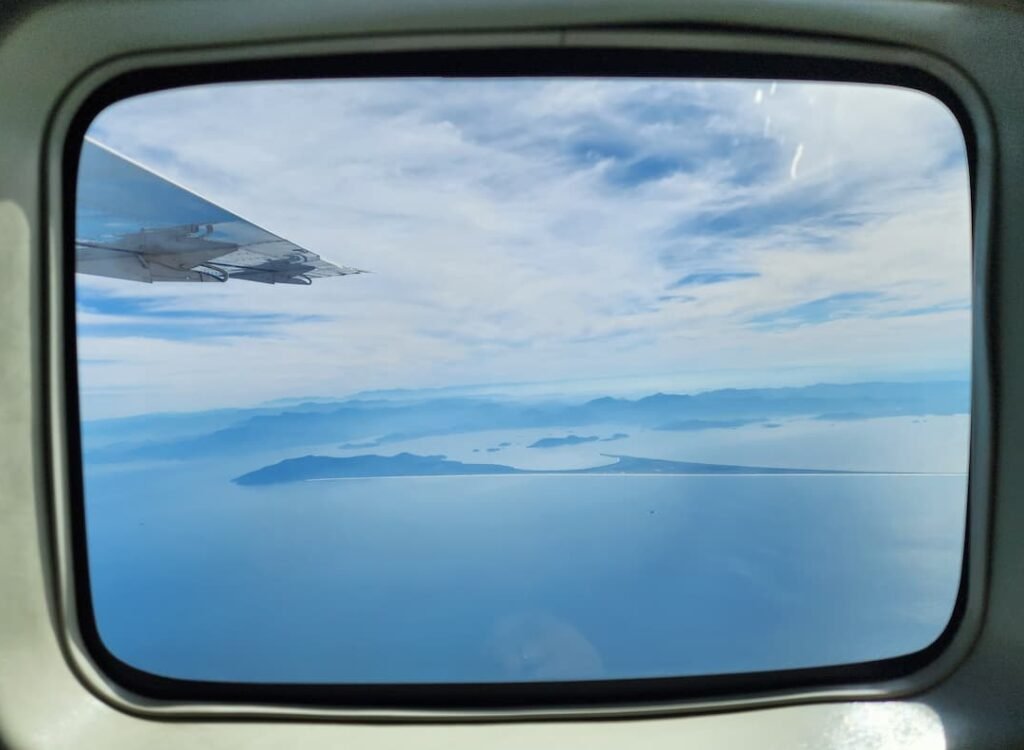
According to FlyFlapper, only 12 accidents involving Cessna Grand Caravan aircraft occurred in Brazil between 2010 and 2019. Of these, two were fatal, two resulted in aircraft destruction, and 13 were classified as serious incidents (source: Sipaer/Cenipa Panel).
The most well-known incident happened in 2019 with the PT-MHC aircraft operated by TwoFlex after departing from Manaus Airport. Fortunately, there were no fatalities (source: Aeroflap).
Between 2016 and 2020, the Cessna Grand Caravan accumulated 141,018 flight hours in Brazil, according to ANAC (the Brazilian equivalent of the US FAA). Considering Cenipa (the Brazilian equivalent of US NTSB) data for the same period, which reports six accidents (one fatal), the accident rate for the Cessna Grand Caravan in Brazil stands at 0.004%, slightly lower than in the U.S. The fatal accident rate is 0.001%.
Importantly, none of the reported accidents occurred in regular commercial operations like those of Azul Conecta, which follows rigorous safety protocols.
Purchasing Tickets
Tickets for Azul Conecta flights can be purchased directly on the Azul Linhas Aéreas website. Travelers can also book flights from Jacarepaguá to other domestic destinations, such as Brasília, via a connection in Congonhas.
With the launch of the Jacarepaguá-Campinas route on June 8, 2024, international connections have become available as well.
A great tip is to use TudoAzul (Azul’s frequent flyer program) points to book tickets. Sometimes, fares are very affordable; in our case, we secured tickets for just 10,000 TudoAzul points.
Jacarepaguá Airport

Jacarepaguá Airport (RRJ), inaugurated in 1971, is a small airport in Rio de Janeiro primarily serving offshore flights to oil platforms in the Santos Basin.
Located on Ayrton Senna Avenue, one of the main roads in Barra da Tijuca, it sits approximately 4 km from Avenida Lúcio Costa, the beachfront avenue of Barra da Tijuca.
Its 900-meter by 30-meter runway is frequently used by private aircraft, aerial advertising companies, and the Aeroclub of Brazil. Azul is the only major airline operating scheduled flights from this airport, offering connections to Congonhas – São Paulo (CGH) and, since June 2024, Viracopos – Campinas (VCP).
The terminal is small, with minimal passenger facilities, including limited seating, a snack bar, restrooms, and a water fountain.
Most passengers are employees and contractors of Petrobras, who use a separate building as their support facility.
In September 2023, PAX Aeroportos took over the airport’s operations as part of a concession that also includes Campo de Marte Airport in São Paulo. The concession is expected to bring new terminals with modern infrastructure and improved passenger amenities, along with additional flight routes.
New flights from Jacarepaguá to Campinas and Belo Horizonte, operated by Azul Conecta, began in June and July 2024, respectively.
Check-In
Passengers traveling between Jacarepaguá and Congonhas must check in online before arriving at the airport. There were no check-in counters for Azul flights (though counters are available for helicopter flights to offshore platforms), nor are there self-service kiosks (as for june 2023).
Airport staff members only verify documents, manually tag luggage, and oversee boarding. It is advisable to purchase checked baggage allowance in advance.
Despite the limited facilities, the check-in and boarding process is quick and efficient.
Flight Highlights
1. Boarding in Jacarepaguá
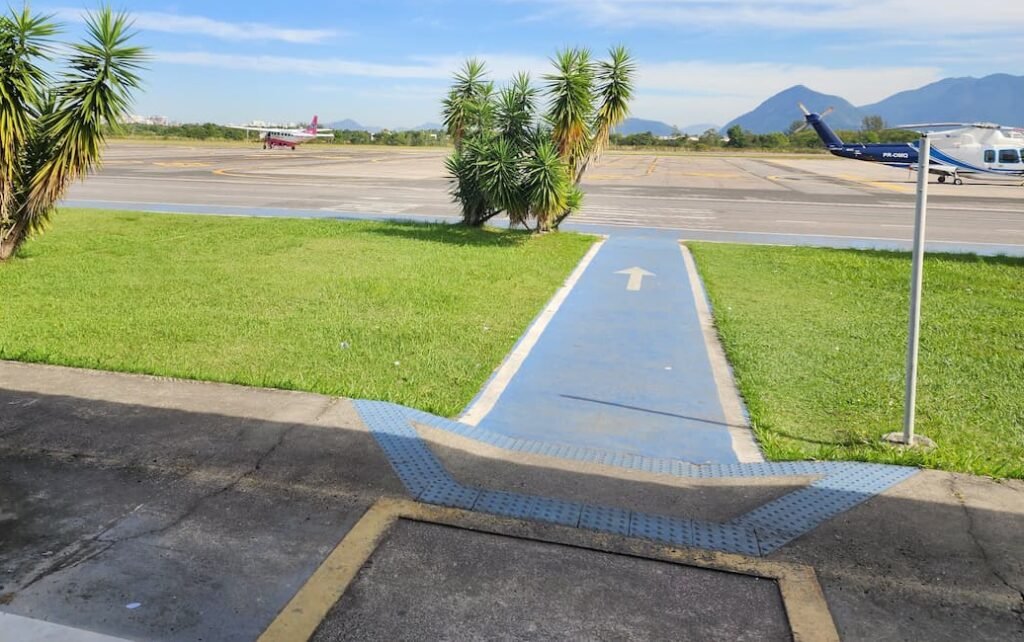
Unfortunately, the boarding lounges at Jacarepaguá Airport were overcrowded with passengers (mostly from helicopter flights). We arrived early and chose to wait outside the airport, watching the aircraft movements.
Once boarding was announced, we walked across the tarmac to the aircraft, carrying our checked luggage. An Azul Conecta employee collected the luggage on-site to place it in the cargo compartment. Hand luggage had to be stored in the rear section of the aircraft.
2. Jacarepaguá Lagoon

Our flight took off away from the sea (Runway 03). The aircraft banked, and one of the first notable sights was Jacarepaguá Lagoon, part of a lagoon complex in Rio de Janeiro’s western zone.
Adjacent to the lagoon is the Rio de Janeiro Olympic Park, featuring various arenas and facilities used during the 2016 Summer Olympics and Paralympics.
3. Praia da Reserva (RJ)
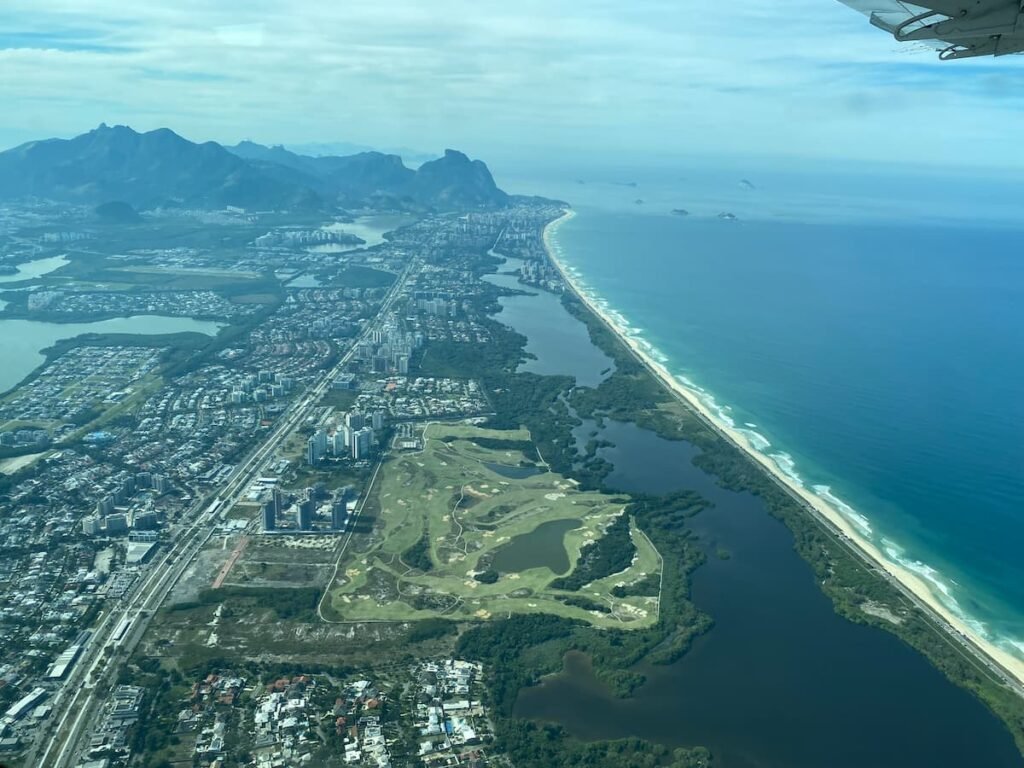
Praia da Reserva (Reserve Beach) in Rio de Janeiro is an 8 km stretch of shoreline between Barra da Tijuca and Recreio dos Bandeirantes, along Avenida Lucio Costa. It’s relatively uncrowded due to the absence of nearby residential areas – Marapendi Lagoon lies directly behind it.
Visitors to Praia da Reserva appreciate its tranquility, though amenities are limited with few beachside kiosks and parking is difficult to find.
4. Restinga da Marambaia (RJ)
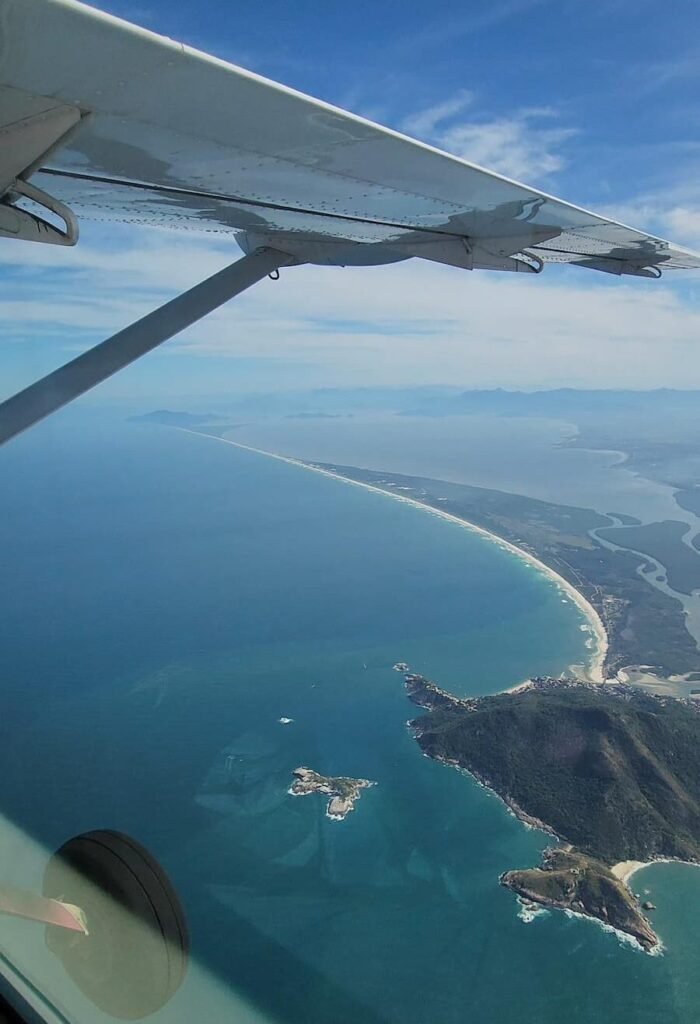
Restinga da Marambaia is a coastal sandbank and island spanning the municipalities of Mangaratiba, Itaguaí, and Rio de Janeiro, in Rio de Janeiro state.
Part of the Costa Verde region, it’s managed jointly by the Brazilian Navy, Army, and Air Force. Unfortunatelly, public access to its beaches is restricted due to military operations, though occasional educational and research visits are permitted for schools and universities.
Adjacent to Restinga da Marambaia is Barra de Guaratiba, a neighborhood providing access to the popular Pedra do Telégrafo hiking trail.
5. Ilha Grande – Angra dos Reis (RJ)

Ilha Grande, part of Angra dos Reis municipality (RJ), is a premier destination for ecotourism, diving, and hiking. It offers a pristine natural sanctuary, free from cars, with welcoming tourist facilities.
As the largest island in Rio de Janeiro state (193 km² or 75 sq mi), it’s a natural paradise featuring idyllic beaches surrounded by Atlantic Forest, challenging trails, and the charming village of Vila do Abraão.
6. Ilhabela (SP)
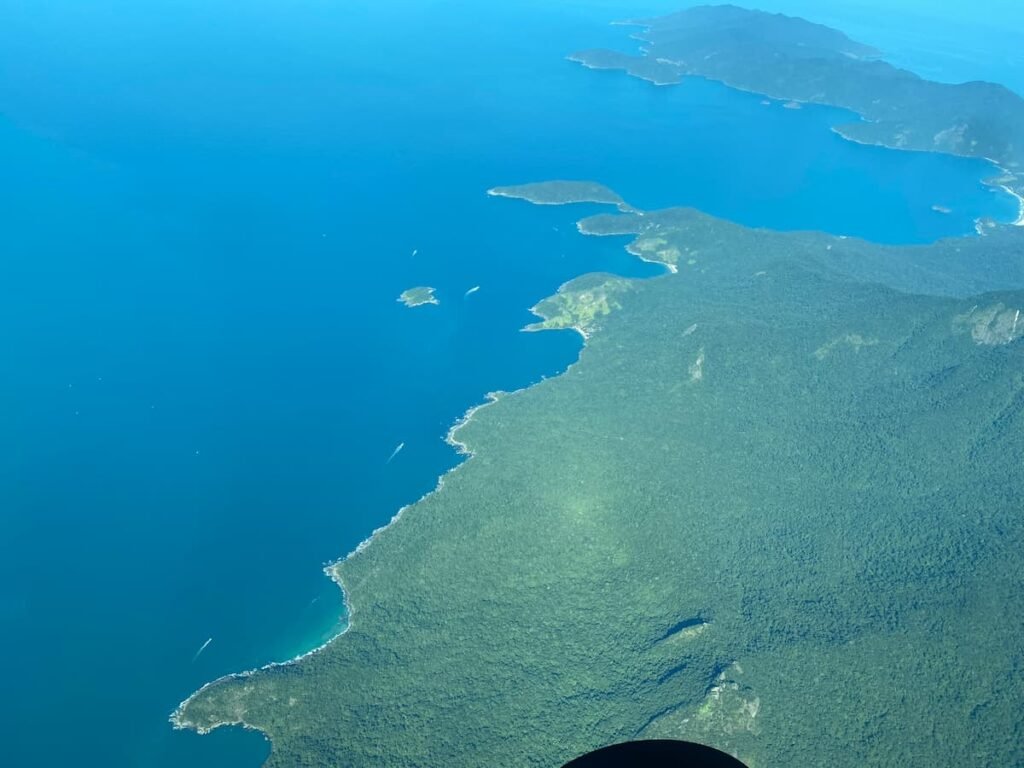
We flew over Ilhabela on the northern coast of São Paulo state (SP). The municipality of Ilhabela is actually a marine archipelago comprising 19 islands, islets, and reefs.
The principal island, Ilha de São Sebastião, covers 348 km² (134 sq mi) and is considered one of Brazil’s largest maritime islands.
Ilha de São Sebastião is also the most populated island, featuring 43 beaches and approximately 350 waterfalls. The region is renowned for its natural beauty, mountainous terrain, and preserved Atlantic Forest.
7. São Sebastião Channel (SP)
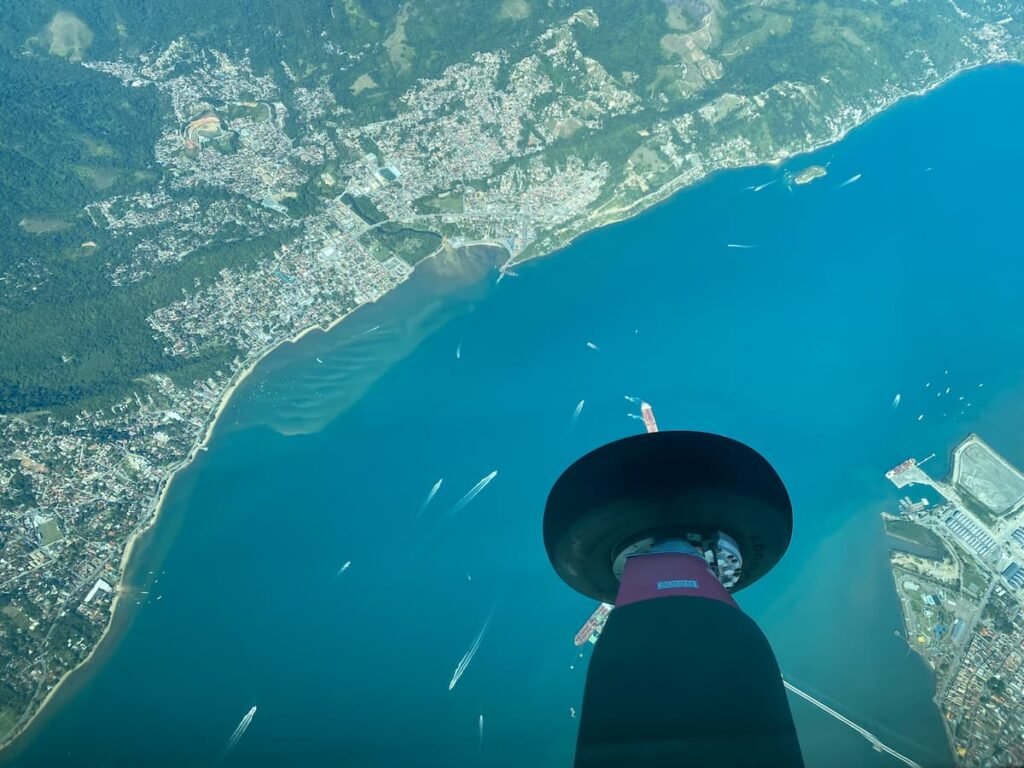
The São Sebastião Channel, also known as the Ilhabela Channel, is the maritime strait separating Ilhabela from São Sebastião municipality (mainland) in São Paulo state.
Extending roughly 8 miles in length and narrowing to about 1,800 feet at its narrowest point, the channel is a vital hub of marine biodiversity, home to diverse fish species, marine mammals, birds, and corals.
Ferry services cross the São Sebastião channel between São Sebastião and Ilhabela.
Near the ferry terminal is the Petrobras Terminal, where oil is pumped to refineries throughout São Paulo state.
8. Guarujá (SP)
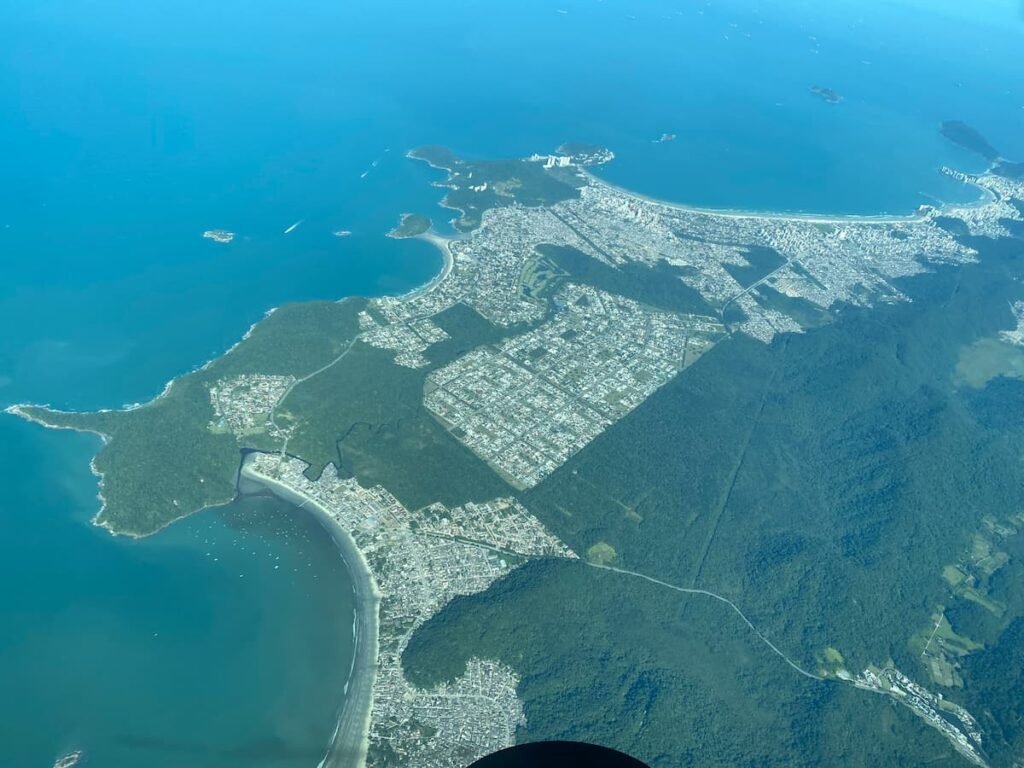
We approached the mainland over Praia do Perequê (Perequê Beach) in Guarujá, São Paulo state, near “Ponta da Santa” and Praia do Cuiúba.
Guarujá is a municipality in the Baixada Santista region, a popular destination for residents of the São Paulo metropolitan area.
Known as the “Pearl of the Atlantic” for its beautiful beaches and natural scenery, it’s geographically situated on Ilha de Santo Amaro, the third-largest island along São Paulo’s coastline.
9. Port of Santos (SP)

The Port of Santos is Latin America’s largest port and among the world’s most significant. Located in the Santos estuary, it extends through the municipalities of Santos, Guarujá, and Cubatão.
This massive port complex specializes in cargo storage and handling, as well as passenger services. It processes a diverse range of cargo, including solid and liquid bulk, general cargo, containerized freight, and project cargo.
10. Guará-Vermelho Reserve, Cubatão (SP)
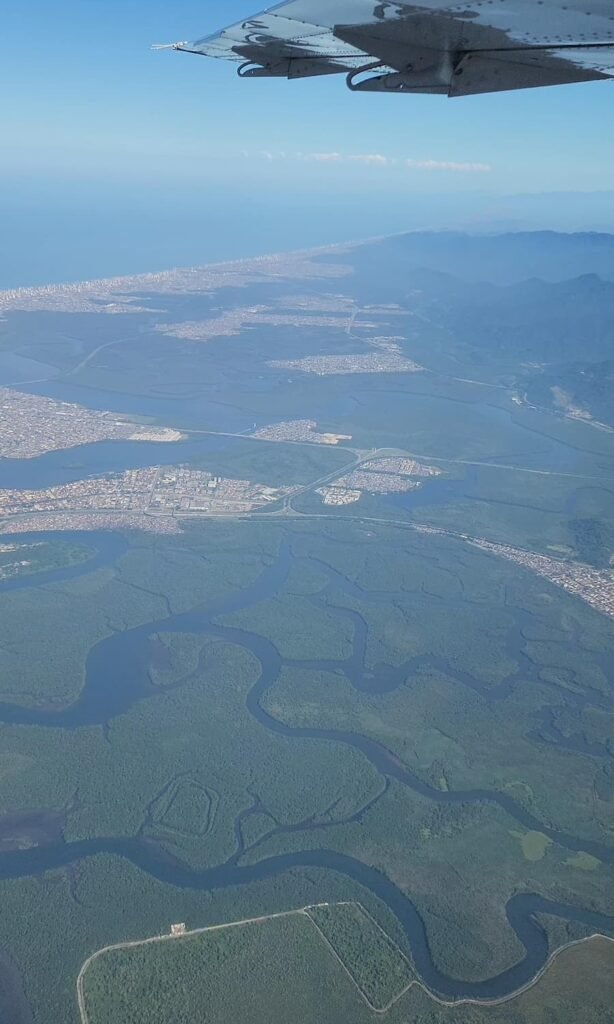
The Guará-Vermelho Reserve is a conservation and environmental awareness initiative in Cubatão, São Paulo state. The project was established by the NGO Nudaer and received approval from the Petrobras Socioambiental Program in 2021.
The Scarlet Ibis (Guará-Vermelho), which symbolizes environmental recovery in Cubatão, is the project’s primary focus.
11. Serra do Mar (SP)
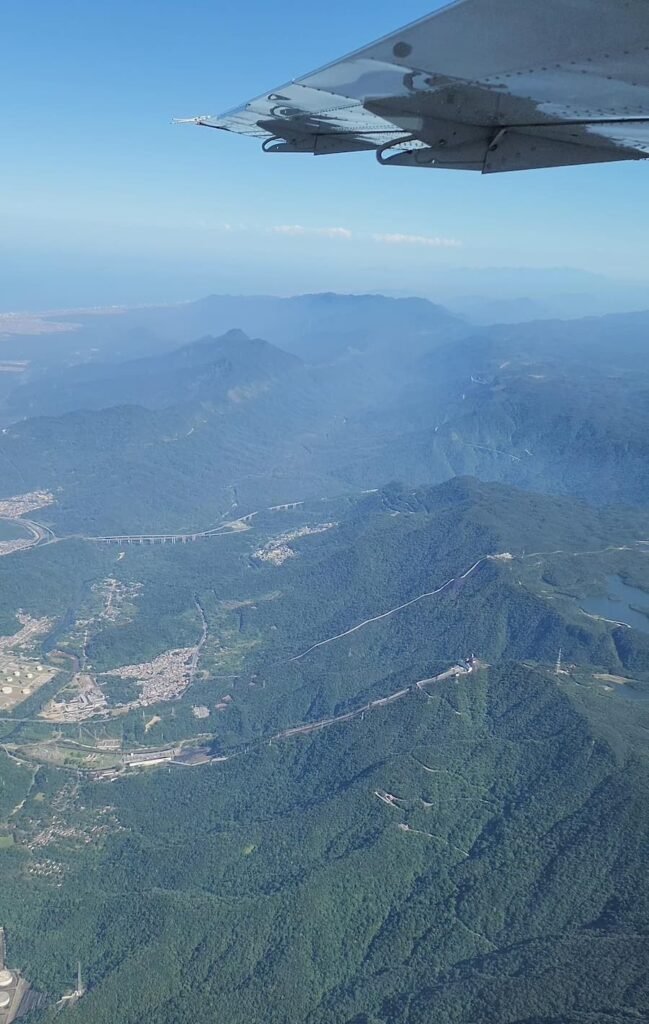
Without a doubt, the Serra do Mar mountain range in the state of São Paulo was the highlight of our flight. The dramatic elevation difference between the coastal cities and São Paulo’s metropolitan region is breathtaking.
The mountain ascent resembles a giant step that takes considerable time to climb by land, but offers only a few minutes of spectacular views when traveling by air.
Ahead, you can see the Anchieta Highway and, in the background, the Imigrantes Highway. Both connect São Paulo to the southern coast of the state.
12. Rio das Pedras Reservoir (SP)
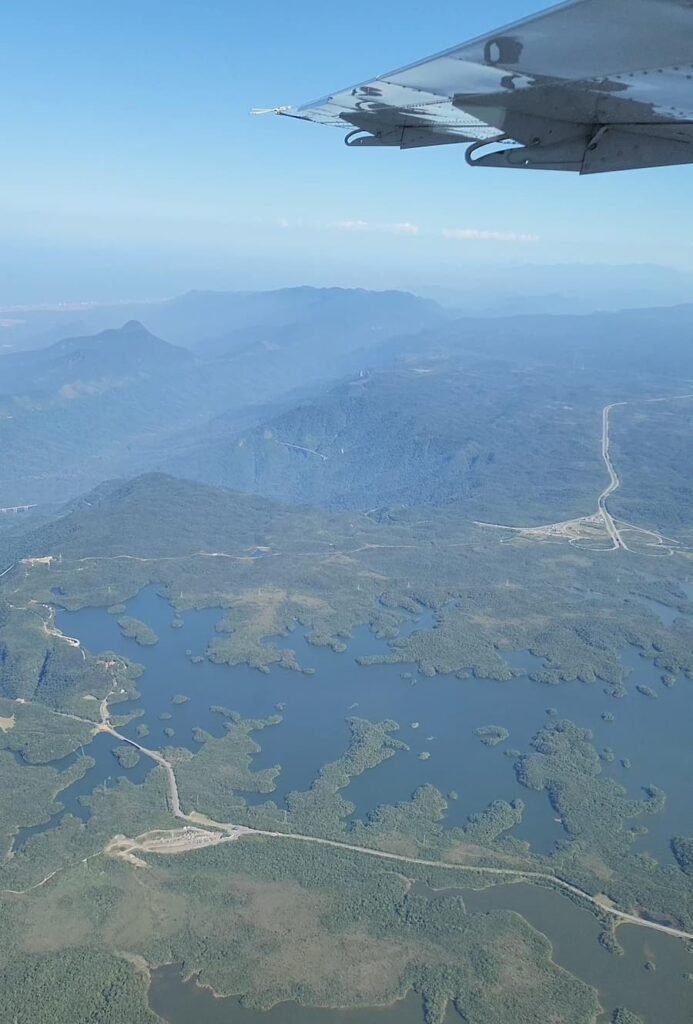
The Rio das Pedras Reservoir is situated in the Upper Serra do Mar, in São Bernardo do Campo municipality (SP).
Built in 1926, it was designed to receive water from the Billings Reservoir via the Billings-Pedras Regulating Dam, for subsequent electricity generation at the Henry Borden Plant in Cubatão (SP).
13. Billings Dam (SP)
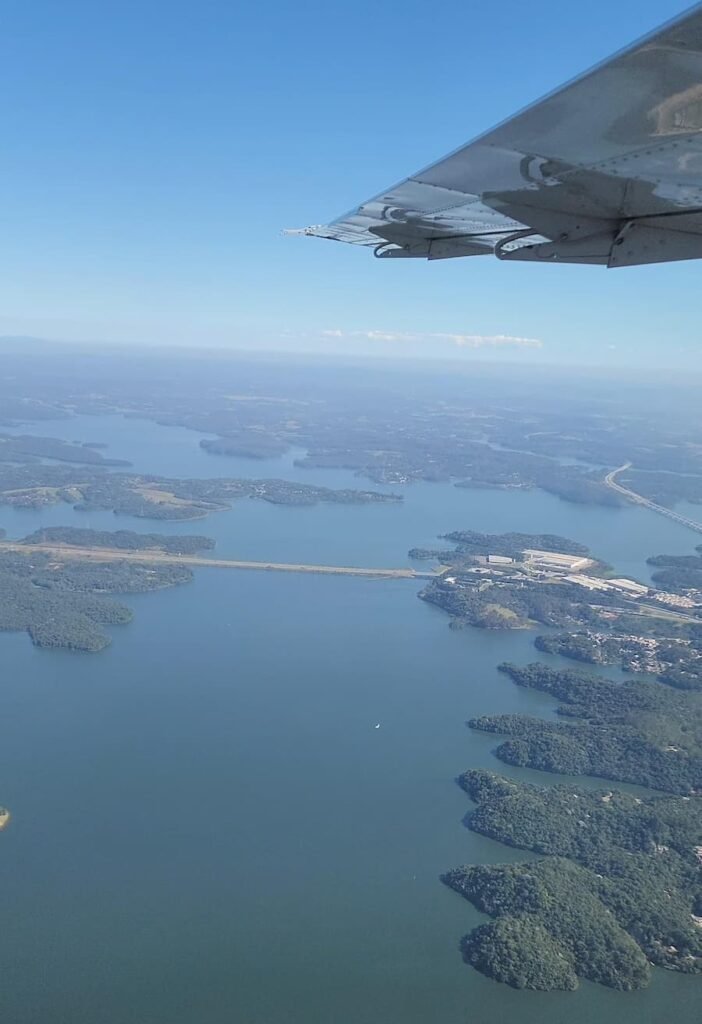
The Billings Dam is one of the most crucial water reservoirs in the São Paulo Metropolitan Region, primarily used for public water supply.
It was conceived on March 27, 1925, by engineer Billings, who worked for the former electric power concessionaire Light. Initially, the dam was built to store water for generating electricity at the Henry Borden hydroelectric plant in Cubatão.
14. São Bernardo do Campo (SP)
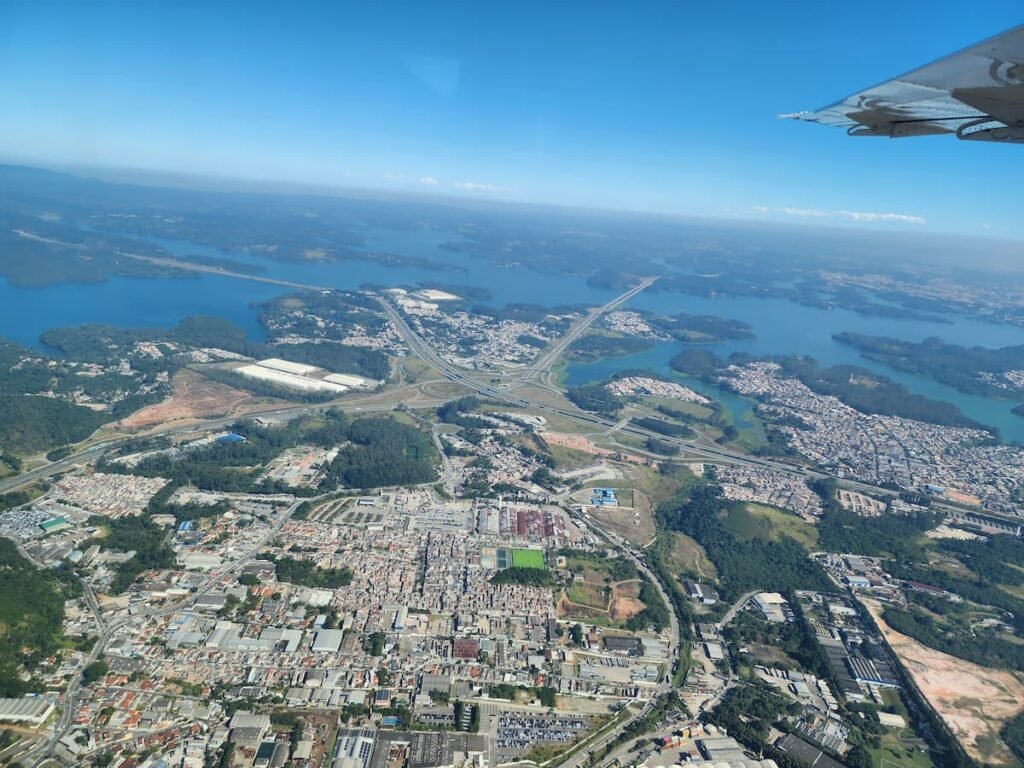
São Bernardo do Campo is a municipality in the São Paulo metropolitan region, renowned as the birthplace of Brazil’s automotive industry and labor movement. It forms part of the ABC region, along with Santo André, São Caetano do Sul, and Diadema municipalities.
15. Jabaquara Metro Yard (SP)

The Jabaquara Metro Yard is a maintenance facility for Line 1 of the São Paulo Metro, with capacity to park 52 trains. It houses maintenance workshops and administrative buildings, and serves as an important operations center for the São Paulo Metro system.
Construction began 50 years ago, on April 1, 1971, radically transforming the local landscape, which was previously lowland occupied by several farms. The yard connects to Jabaquara Metro Station, the southernmost station of Line 1, which was São Paulo’s first subway line (1974).
16. Congonhas Airport (SP)
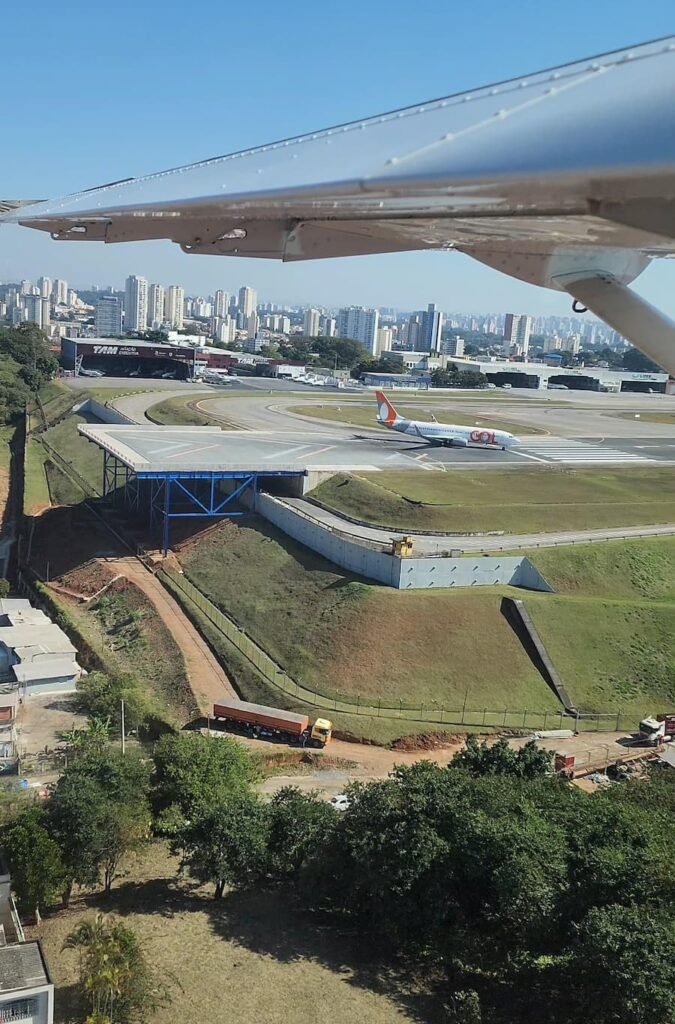
Congonhas Airport (CGH), in southern São Paulo, is Brazil’s second-busiest domestic airport, trailing only São Paulo International Airport (GRU). In September 2023, Aena Brasil took over the airport’s operations as part of a concession that also includes other airports in the state of São Paulo.
It features two runways: the main runway (17R/35L) measuring 1,940 meters, and the auxiliary runway (17L/35R) at 1,345 meters.
Built in the 1930s in what was then a remote area on the border between São Paulo and Santo Amaro municipalities – a year before Congonhas opened, the neighboring village was annexed to São Paulo specifically to accommodate the new airport.
The airport is named after Viscount Congonhas do Campo, Lucas Antônio Monteiro de Barros (1823-1851), who served as the first governor of São Paulo Province after Brazil’s independence. Over time, the city grew around the airport, creating various challenges and impacts for residents, including noise pollution and traffic congestion.
Our landing was on the auxiliary runway, and we observed a Gol aircraft taking off just seconds after we touched down.
Tips and Essential Information
If you’re traveling from Rio de Janeiro to São Paulo, the most interesting views initially appear for passengers seated on the right side of the aircraft. As you approach the São Paulo coast, the best views shift to the left side.
Avoid traveling with Azul Conecta during rainy seasons due to the risk of flight cancellations. June is an excellent month for the Rio-São Paulo route, with typically more affordable fares.
Don’t forget to bring a camera to capture the spectacular scenery.
Avoid moving around the cabin, as the aircraft flies at lower altitudes and is more susceptible to turbulence.
Summary
The flight between Jacarepaguá and Congonhas is one of the most scenic routes I’ve experienced in Brazil. Observing the dramatic coastline of Rio de Janeiro and São Paulo states from above is truly remarkable.
This journey offers a unique opportunity to gain a panoramic perspective of places typically seen only from ground level.
By following the tips above, I’m confident you’ll have an unforgettable travel experience.
Did you like our trip? Check out all our travel articles in English by clicking here.
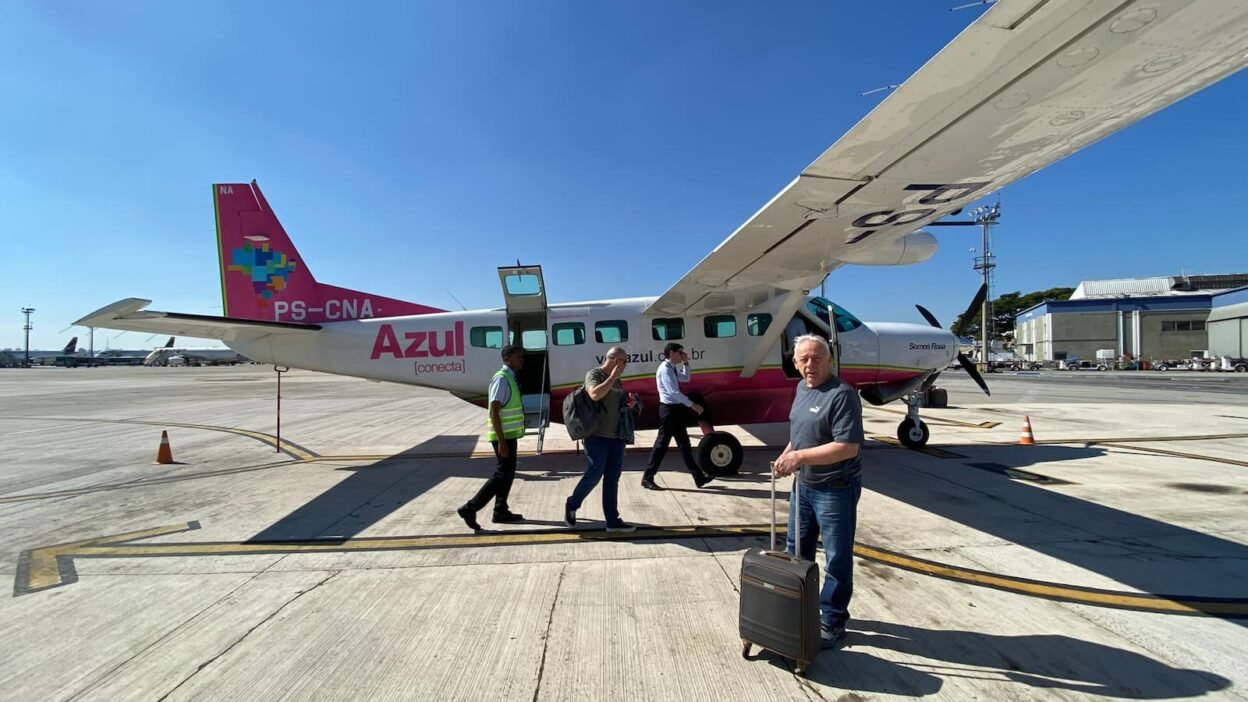
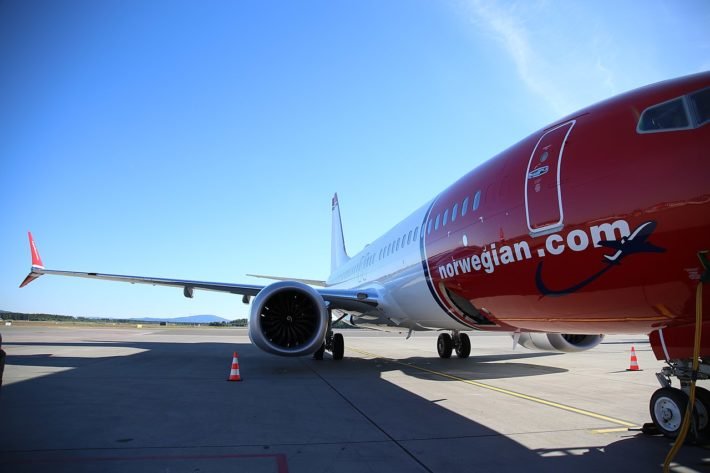
![Review: Eva Air 777 Business Class [for only 13k Lifemiles] 23 Boeing 777-300ER, Eva Air](https://classeturista.com/wp-content/uploads/2020/01/Boeing-777-300ER-Eva-Air-e1601083429600.jpg)
